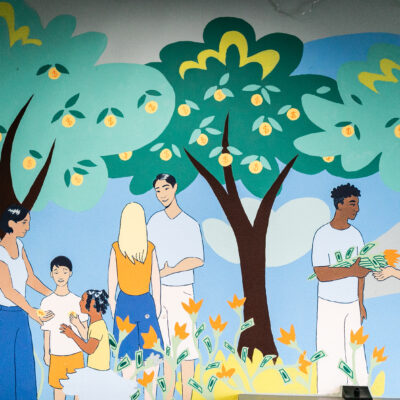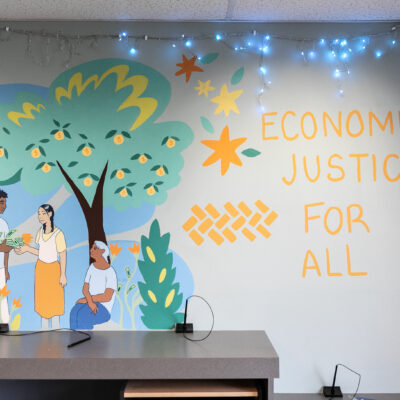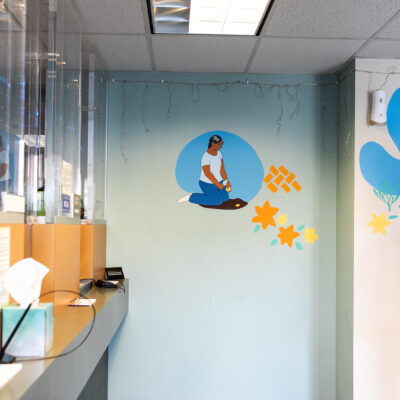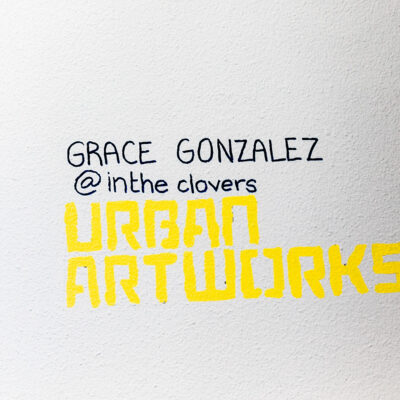This Artist Spotlight features a talented muralist whose creative journey with Urban ArtWorks began with a single volunteer day and has since grown into collaboration, murals, and community storytelling. Last year, we worked with Grace Gonzalez on a mural that addressed themes of pathways, growth, and sustainability for the interior of a local credit union. In our conversation, she reflects on how public art transforms neighborhoods, the power of artistic connection, and how her work helps her rediscover and celebrate her cultural heritage.
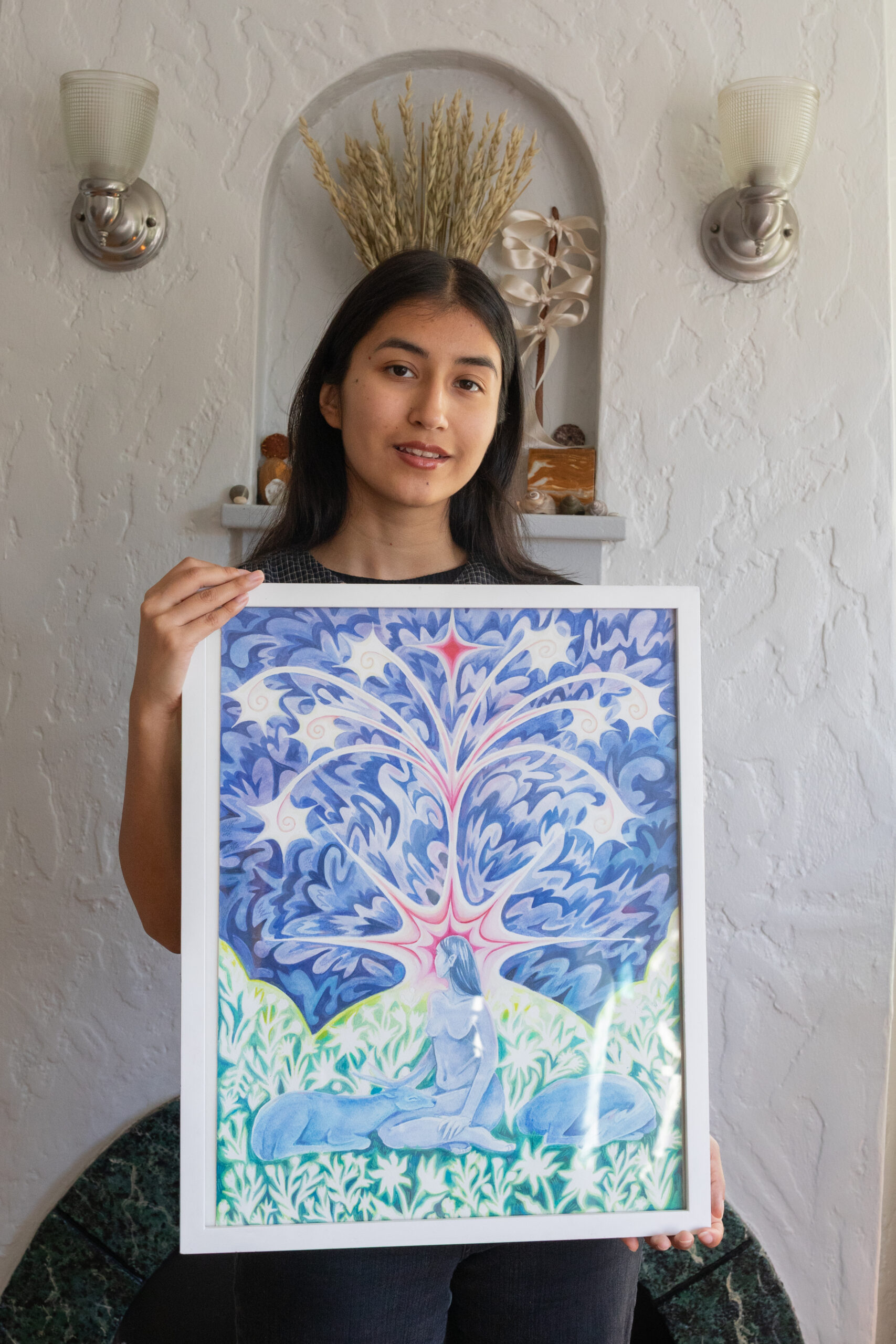
How did you first get involved with Urban ArtWorks?
I believe it was for the installation of the 63rd St Mural, where Urban Artworks had reached out to artists to help with paint support.
Can you share a memorable moment or experience you’ve had working on mural or production projects with Urban ArtWorks?
That first time I worked with Urban Artworks was probably the most memorable. I had been wanting to get involved in the organization for a while and lived nearby so signed up to help paint. I showed up not really knowing anyone, but by the end really felt like I had taken a part of something bigger than me. It was a really lovely experience to see all the people who came to see this big project through and to see all the designs that the local artists had come up with. I met a lot of people that day and it led to a lot of opportunities—both opportunities for myself personally and opportunities to help support further projects that other artists had created.
What stands out to you about collaborating with other artists or supporting large-scale public art projects?
When I was just a baby artist, before I had ever been involved with public art, making art was a very solitary experience. It was me, painting in my room, alone for hours. In some ways, that level of focus and passion could be very fruitful in its own way. But through helping bring public art projects to fruition I’ve realized how much art can bring entire communities together. You meet so many people. You meet so many other artists, all of whom have different backgrounds and specialties, and you begin to see how there is really no one way to be an artist. Everyone has found their own way. It really empowers you to feel like you don’t have to compromise yourself in order to find success in the art field and allows you to dream bigger.

You’ve mentioned having experience working with youth and art — how have those experiences shaped your creative approach or perspective?
I didn’t have much support when I was young in my art journey and had to figure a lot of it out myself so it’s actually really healing to be able to be more of a mentor figure and give guidance where I can. I think the big thing is I love to let young artists know there is no one way to do this, and that they can fully commit to themselves and their passion and have it go somewhere.
How do you approach representing communities and their stories in your artwork while incorporating your personal experiences and emotions?
We live in an ecosystem of thought and action and experience. No one’s experience exists in a vacuum — it is done in relationship and reaction to these greater relationships and systems. I try my best to learn from multiple different perspectives within a community and reflect on how I personally empathize and relate to those perspectives. Usually there is some sort of throughline between them that I can utilize to weave together a narrative. I like creating new metaphors by referencing symbols or motifs from mythology to expand on feelings or experiences that people are having right now.
Why do you believe public art is important for communities, and how does it function as a medium for social change and raising awareness?
I think, like I mentioned before, public art inherently brings people together. It requires collaboration in its inspiration, ideation and installation. And then, after it has been created and has become a part of the landscape of a neighborhood, it is seen day after day by anyone and everyone who passes by that spot. It is a key element to the design of a city that builds trust and identity into a community. To see a work of art in the place you live gives you hope that there are people around you who care about that place and are willing to put real creative energy and work into making it better. It is in that trust that people can begin to have real conversations with each other. Change is a difficult thing for anyone to navigate alone, and without learning from the people around us we won’t be able to understand what alternatives we have to the status quo. Like public art, social change is a collaborative creative process. Public art is a small example of how that process can lead to beautiful and meaningful outcomes.
2024 interior murals for Express Credit Union designs by Grace Gonzales painted with credit union support and Urban ArtWorks.
What advice would you give to youth or emerging artists who want to pursue art professionally?
Two big things:
1) Give time to your art and your art practice — understand why you make things and push yourself to create even if it’s just a doodle or a sketch or purely for fun. Play with shapes and colors and ideas and don’t hold yourself to feeling like it must be perfect or complex. Make art-making a necessary part of how you interact with the world. Don’t let yourself forget why you love it; always have a tether to it that is purely personal.
2) Go out to art events, talk to people, get involved in organizations, get involved in supporting roles for other people’s art, find out whose practices or career trajectories you admire — ask them for advice! Be a part of your local art scene. Not only are those relationships educational, inspiring, and fulfilling, not only do you get to feel more a part of the city you’re in, but those are the spaces where you will actually find opportunities and get chances to collaborate. Of course applying to grants and calls for art are also fruitful, but building a creative support system is vital, and will teach you so much about how to build a sustainable practice for yourself. None of this work ever gets done alone! It is so much easier to create when you have people to bounce ideas off of or who can help you with the practical side of seeing a project through. And it is incredibly fulfilling to reciprocate that support as well.
Are there any upcoming projects or collaborations you’re particularly excited about?
I am currently working with the Uptown Arts and Culture Coalition in Uptown/Lower Queen Anne on a project to bring more color and whimsy to the crosswalks in that neighborhood. It’s my first project in which I’ve had a hand in project management, and I’ve learned a ton throughout the process. It will still be a while (probably 2026) before we’ll see the final results, but I’m super excited to see it all come together!
How do you celebrate and represent your culture through your art?
Art is actually my means of reconnecting with my culture. I didn’t grow up with much connection to my Mexican heritage. Through art, I have begun to build my own relationship to those histories. A lot of the symbols I use are inspired by Mexican folk-art or mythology. Every culture is at its very core a story for how the world works and how to navigate that world. A lot of my exploration of my heritage is in working through which symbols or metaphors speak to me, learning what that story is and how to carry it into my life. There is also a part of me that is American — this is where I was born and grew up — and art can be a safe place to explore how those two things can intertwine, or how I can make a new way of being for myself entirely that can encapsulate all those parts of myself.




